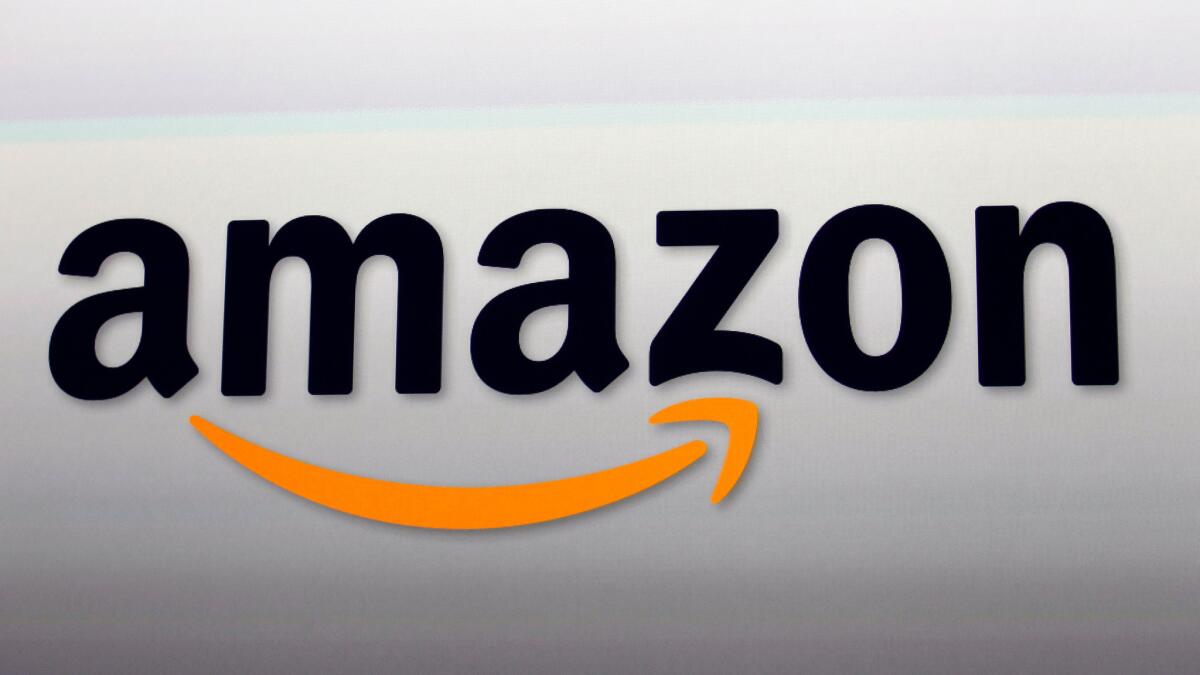Amazon appears to be considering opening more brick-and-mortar stores selling groceries and apparel

- Share via
Amazon’s keen on both fashion and retail — and whether those interests ever intersect could help shape the next leg of the digital retail revolution. The Seattle-based Amazon has already opened two bookstores (three more are on the way) and multiple pop-up mall kiosks. Now the endless aisle behemoth is reported to be looking at opening more brick-and-mortar outposts that could sell groceries and other items, potentially apparel.
If Amazon did venture into physical retail in a more prominent way, it would follow in the footsteps of other direct-to-consumer brands such as Bonobos and Warby Parker that have ventured beyond their digital roots to meet the needs of shoppers.
KeyBanc Capital Markets analyst Ed Yruma said that apparel and groceries are two categories of strategic importance to Amazon.
For groceries, Yruma predicted Amazon would pursue a “click-and-collect” approach in which the customer orders online then drives to pick up the groceries, similar to models that have been tested by Wal-Mart and Target.
That approach might make more sense for groceries than apparel.
“Apparel is cheap to ship,” said Yruma, noting it is not heavy and is valuable, compared to groceries. It also does not require refrigeration.
“Look at Zappos and showrooming, when someone will order 20 pairs of shoes [online] and send back 18,” Yruma said, suggesting that Amazon, like Warby Parker, Bonobos and ModCloth, could approach apparel stores with a showroom concept. That would let shoppers view and try on merchandise that could be shipped later or pulled from a storeroom in the back, similar to a shoe store.
“Ultimately for Amazon, like a lot of e-commerce players have indicated, the future of retail is in both physical and e-commerce — which is not to say that they are ever going to be a Gap or Urban Outfitters,” Yruma said.
Amazon has already installed pop-up kiosks in about 20 malls to primarily sell its own electronic devices, but the analyst said it would not behoove Amazon to treat malls like warehouses, as its more than 100 American distributions centers are more efficient and less expensive than mall real estate.
One major incentive for Amazon to invest in store locations would be to use them as a marketing tool for its fashion segment, said Mabel McLean, who is director of Amazon IQ at research firm L2. The firm has studied the effects of opening a physical store on pure-play retailers, among them Trunk Club, Rent the Runway and Warby Parker, and found that after opening a store, each saw a spike in search activity that was relatively sustained.
She said it would be strategically advantageous for Amazon to open fashion-specific, brick-and-mortar locations to publicize its offering.
“Amazon has done a great job in getting cool brands to distribute through them, such as Loeffler Randall, Chloé and Parker, but their products are hard to find through Amazon’s user interface,” McLean said. “I think that their fashion program hasn’t gained as much traction as they had hoped.”
Earlier this week, LVMH Moët Hennessy Louis Vuitton chief executive officer Jean-Jacques Guiony said that in its current state, the company would not consider working with Amazon. “We believe that the existing business of Amazon doesn’t fit with luxury, full stop, but also doesn’t fit with our brands,” which include Dior, Givenchy, Marc Jacobs and Louis Vuitton. “If they change the business model, I don’t know, but with the existing business model, there is no way we can do business with them for the time being.”
L2’s McLean said Amazon’s current store rollouts have been very vertical-specific — focusing on books or devices — and noted that unless the web giant goes after a Wal-Mart-style approach, it would be difficult to concentrate all of its inventory into one location.
“To go into a physical store where you buy everything would be overwhelming and not very rewarding or not satisfying for a retail experience,” McLean said.
Doug McMillon, president and chief executive officer of Wal-Mart Stores Inc., said this month the firm’s its physical stores were an advantage it had over Amazon.
He noted that customers like stores and if Wal-Mart has good stores, some portion of the business will be pure in-store shopping. McMillon referred to in-store shopping as a social experience, emphasizing that although the retailer is increasingly focusing on the digital realm, 90 percent of Wal-Mart’s business is still done in a store.
“It is really going to be true that that’s seamless or omnichannel … is going to be the winning strategy. Customers will interact with Wal-Mart, they will not think about how they’re interacting very much, and we’ll build the capabilities to serve them in total,” McMillon said. “Being a good store operator matters, the locations matter, the merchant D&A matters, the culture of the company matters.”
Shoptalk chief retail strategist Sucharita Mulpuru said “anything is possible” for the future of Amazon — a notion that energizes people looking for a digital retail revolution and should terrify competitors.
“On the one hand, Amazon would like to win in fashion, but they like to be inventory-light,” Mulpuru said. “Given those constraints, maybe they could buy a department store and lease space to fashion brands like the European department stores do.”
Still, she agreed that Amazon tends to be “partial” to a smaller footprint, so a showroom or a returns kiosk would be more likely.
“But I don’t know that they need to do anything with apparel in the physical world,” she said. “More apparel is shifting online and most apparel stores are an Amazon showroom at some level. Items that are commoditized at the low and medium end are widely available on Amazon and Amazon is generating increasing sales in those products, especially as it manufactures more apparel itself.”











